Table of Contents
- Introduction
- Editor’s Choice
- Data Center Accelerator Market Overview
- Competitive Landscape of Overall Data Center Market
- Regional Landscape of Overall Data Center Market
- Leading Countries by Number of Data Centers
- Data Center Traffic Statistics
- Components of Data Center Accelerator Statistics
- Key Investments
- Regulations for Data Center Accelerator Statistics
- Recent Developments
- Conclusion
- FAQs
Introduction
Data Center Accelerator Statistics: Datacenter accelerators, are integral to modern computing infrastructure. Optimize specific computational tasks by offloading them from the central processing unit (CPU).
Types include GPUs, FPGAs, and ASICs, each tailored for different workloads such as AI, machine learning, and scientific simulations.
Their parallel processing capabilities expedite computations, enhancing performance and efficiency. Accelerators integrate into data centers through dedicated cards, integrated designs, or cloud services.
Supported by software frameworks like CUDA and TensorFlow, they offer benefits like improved performance, energy efficiency, and scalability.
Overall, data center accelerators are pivotal for accelerating complex tasks and driving advancements in computing across various industries.
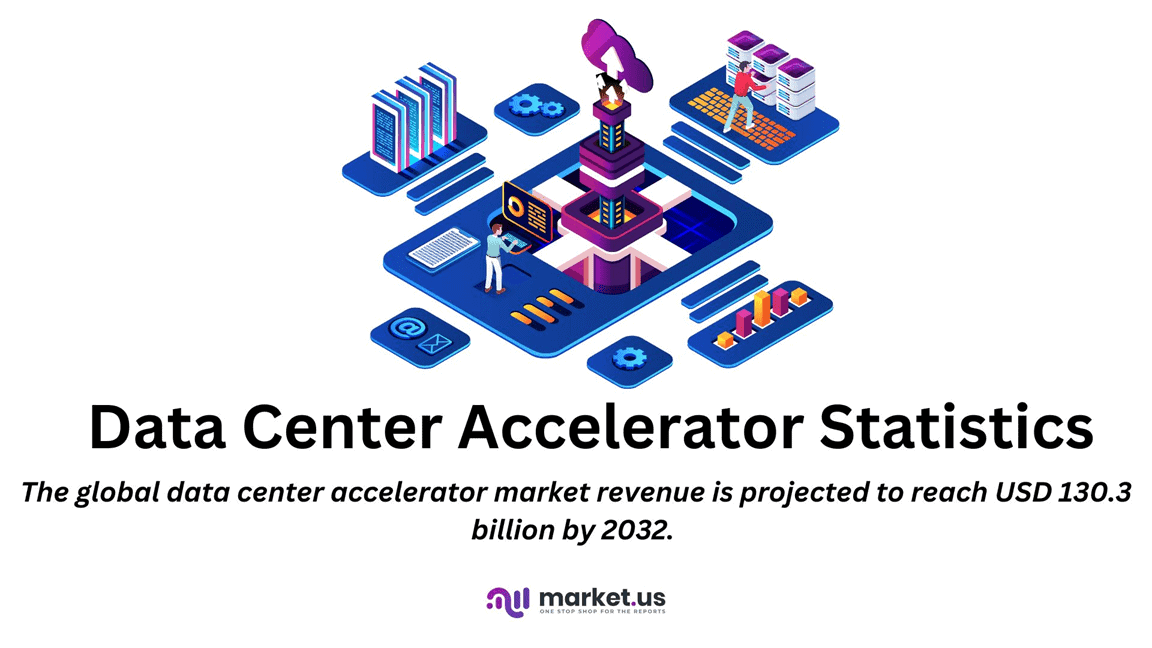
Editor’s Choice
- The global data center accelerator market revenue reached USD 19.8 billion in 2023.
- By 2032, the market is expected to attain a significant milestone of USD 130.3 billion. With cloud data centers generating USD 77.66 billion and HPC data centers USD 52.64 billion.
- In the global data center accelerator market, the distribution of market share among various processor types is quite distinct. Central Processing Units (CPUs) hold the largest share, accounting for 33% of the market.
- In the data center market, Dell leads with a significant 13% share, underscoring its strong influence in the industry.
- The data center market revenue distribution across various countries highlights significant regional differences in market size. The United States leads the global market with a substantial revenue of USD 99.16 billion.
- By 2020, the cloud data center IP traffic had escalated to 16.09K exabytes, and in 2021, it further surged to 19.51K exabytes.
- The AMD Alveo U280 Data Center Accelerator Card features 8GB of HBM2 memory with up to 460GB/s bandwidth, designed for memory-bound. Compute-intensive applications like database analytics and machine learning inference.

Data Center Accelerator Market Overview
Global Data Center Accelerator Market Size Statistics
- The global data center accelerator market has witnessed significant growth over the past few years at a CAGR of 24%. With revenues increasing from USD 16.0 billion in 2022 to USD 19.8 billion in 2023.
- This upward trajectory is expected to continue, with the market projected to reach USD 24.0 billion in 2024 and USD 31.3 billion in 2025.
- By 2026, the market is anticipated to grow to USD 39.7 billion, further expanding to USD 48.0 billion in 2027.
- The momentum is forecasted to carry through to 2028 and 2029. With revenues estimated at USD 55.1 billion and USD 68.4 billion, respectively.
- The market is expected to reach new heights by 2030, with projected revenues of USD 82.7 billion and an impressive USD 102.5 billion by 2031.
- By 2032, the global data center accelerator market is poised to achieve a remarkable USD 130.3 billion. Reflecting a robust growth trend driven by increasing demand for advanced computing capabilities and data processing efficiency.
(Source: market.us)

Global Data Center Accelerator Market Size – By Type Statistics
- The global data center accelerator market, segmented by type, has shown remarkable growth in both the cloud and high-performance computing (HPC) data center segments.
- In 2022, the total market revenue was USD 16.0 billion, with cloud data centers contributing USD 9.54 billion and HPC data centers accounting for USD 6.46 billion.
- This growth trend continued into 2023 when the market revenue reached USD 19.8 billion. With cloud data centers at USD 11.80 billion and HPC data centers at USD 8.00 billion.
- Projections for 2024 indicate total market revenues of USD 24.0 billion, with contributions of USD 14.30 billion from cloud data centers and USD 9.70 billion from HPC data centers.
- By 2025, the market is expected to rise to USD 31.3 billion. With cloud and HPC segments generating USD 18.65 billion and USD 12.65 billion, respectively.
More Insights
- The upward trajectory persists through 2026 and 2027, with total market revenues of USD 39.7 billion and USD 48.0 billion. The cloud data centers contributing USD 23.66 billion and USD 28.61 billion, respectively, while HPC data centers add USD 16.04 billion and USD 19.39 billion.
- The market is projected to reach USD 55.1 billion in 2028, with cloud data centers at USD 32.84 billion and HPC data centers at USD 22.26 billion.
- By 2029, total revenues are expected to be USD 68.4 billion, with cloud data centers contributing USD 40.77 billion and HPC data centers USD 27.63 billion.
- In 2030, the market is forecasted to achieve USD 82.7 billion, driven by USD 49.29 billion from cloud data centers and USD 33.41 billion from HPC data centers.
- The trend is set to continue, reaching USD 102.5 billion in 2031, with cloud and HPC segments contributing USD 61.09 billion and USD 41.41 billion, respectively.
- By 2032, the market is expected to attain a significant milestone of USD 130.3 billion, with cloud data centers generating USD 77.66 billion and HPC data centers USD 52.64 billion.
(Source: market.us)
Take advantage of our unbeatable offer - buy now!


Global Data Center Accelerator Market Share – By Processor Type Statistics
- In the global data center accelerator market, the distribution of market share among various processor types is quite distinct.
- Central Processing Units (CPUs) hold the largest share, accounting for 33% of the market.
- Graphics Processing Units (GPUs) follow closely, capturing 27% of the market share.
- Application-specific integrated Circuits (ASICs) contribute 16% to the market, while Field-Programmable Gate Arrays (FPGAs) hold a significant 24% share.
- This diverse distribution highlights the varied preferences and requirements within the data center accelerator landscape, with each processor type offering unique advantages suited to different computational needs and workloads.
(Source: market.us)

Competitive Landscape of Overall Data Center Market
- In the data center market, Dell leads with a significant 13% share, underscoring its strong influence in the industry.
- Huawei follows with an 8% share, while Hewlett Packard Enterprise (HPE) holds 7% of the market.
- IBM captures 5%, and both Ericsson and NVIDIA each contribute 4% to the market.
- Hitachi, Inspur, Nokia, and Broadcom each hold a 3% share.
- Collectively, these companies account for 52% of the market, leaving the remaining 48% distributed among various other players.
- This diverse composition highlights the competitive nature of the data center market, with numerous companies driving innovation and growth in the sector.
(Source: Statista)
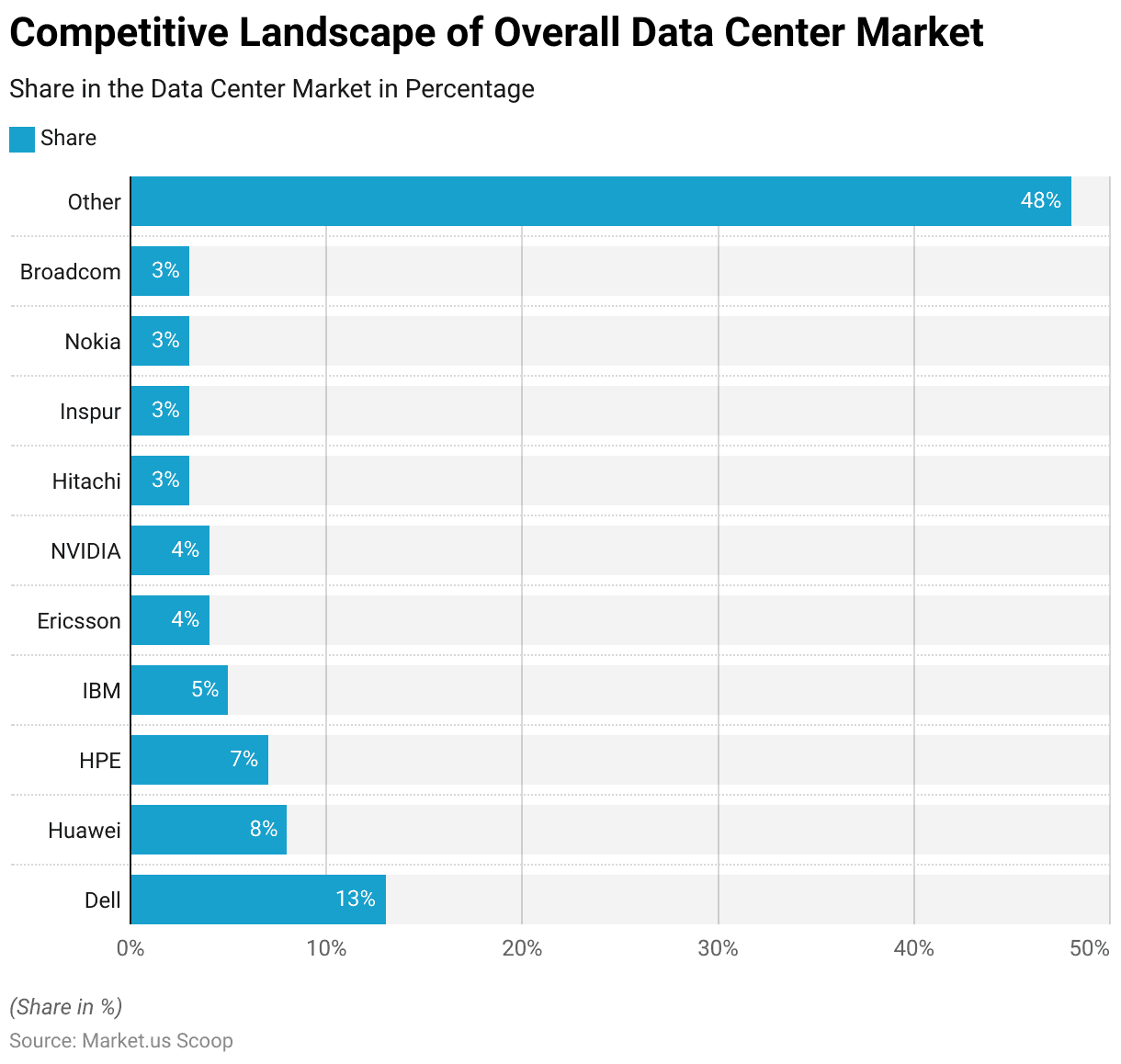
Regional Landscape of Overall Data Center Market
- The data center market revenue distribution across various countries highlights significant regional differences in market size.
- The United States leads the global market with a substantial revenue of USD 99.16 billion, followed by China, which generates USD 69.17 billion.
- Japan holds a notable position with a revenue of USD 18.15 billion, while Germany and the United Kingdom contribute USD 15.76 billion and USD 14.75 billion, respectively.
- France’s data center market revenue stands at USD 9.57 billion, and India follows with USD 7.75 billion.
- Canada and South Korea generate USD 7.31 billion and USD 6.22 billion, respectively, while Italy’s market revenue amounts to USD 5.83 billion.
- This revenue distribution underscores the varying levels of investment and infrastructure development in data centers across these key global markets.
(Source: Statista)

Leading Countries by Number of Data Centers
- As of March 2024, the United States leads the global data center landscape with an impressive total of 5,381 data centers.
- Germany and the United Kingdom follow, with 521 and 514 data centers, respectively.
- China has established 449 data centers, while Canada hosts 336 facilities.
- France and Australia each have 315 and 307 data centers, respectively, and the Netherlands matches Australia with 307 data centers as well.
- Russia operates 297 data centers, and Japan has 251.
- Mexico’s data center count stands at 219, while Italy has 170.
- Brazil and India have 168 and 163 data centers, respectively.
- Poland rounds out the list with 152 data centers.
- This distribution underscores the significant presence of data centers across various key markets worldwide, reflecting the critical role of digital infrastructure in supporting global data processing and storage needs.
(Source: Statista)
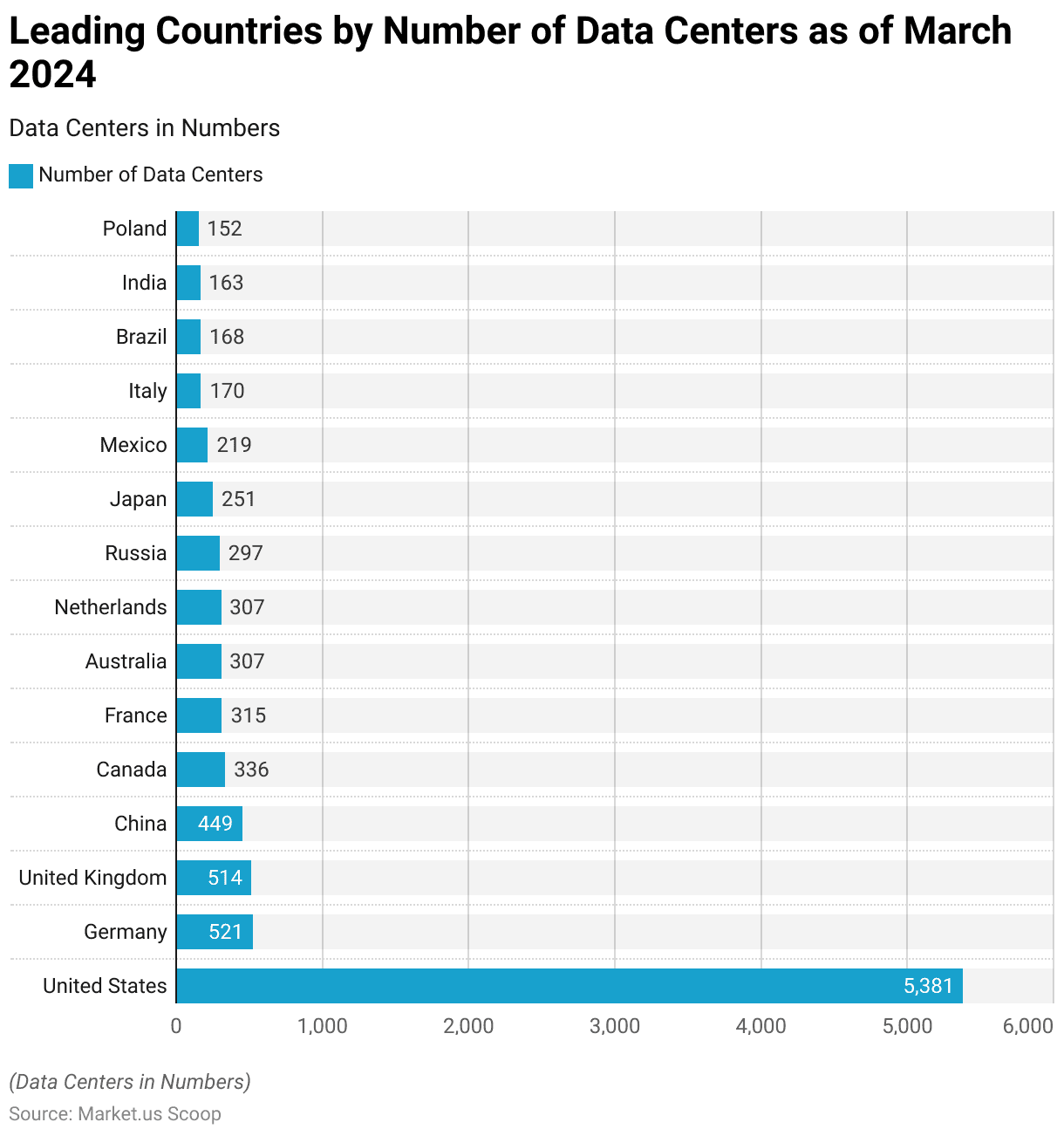
Data Center Traffic Statistics
Cloud Data Center IP Traffic
- From 2015 to 2021, cloud data center IP traffic experienced substantial growth, as evidenced by the annual data traffic figures.
- In 2015, the traffic was recorded at 3.85K exabytes per year.
- This number saw a significant increase in the following years, reaching 5.99K exabytes in 2016 and 8.19K exabytes in 2017.
- The upward trend continued, with traffic volumes hitting 10.61K exabytes in 2018 and 13.13K exabytes in 2019.
- By 2020, the cloud data center IP traffic had escalated to 16.09K exabytes, and in 2021, it further surged to 19.51K exabytes.
- This consistent rise reflects the growing reliance on cloud services and the increasing data generated and processed in cloud data centers.
(Source: Cisco)
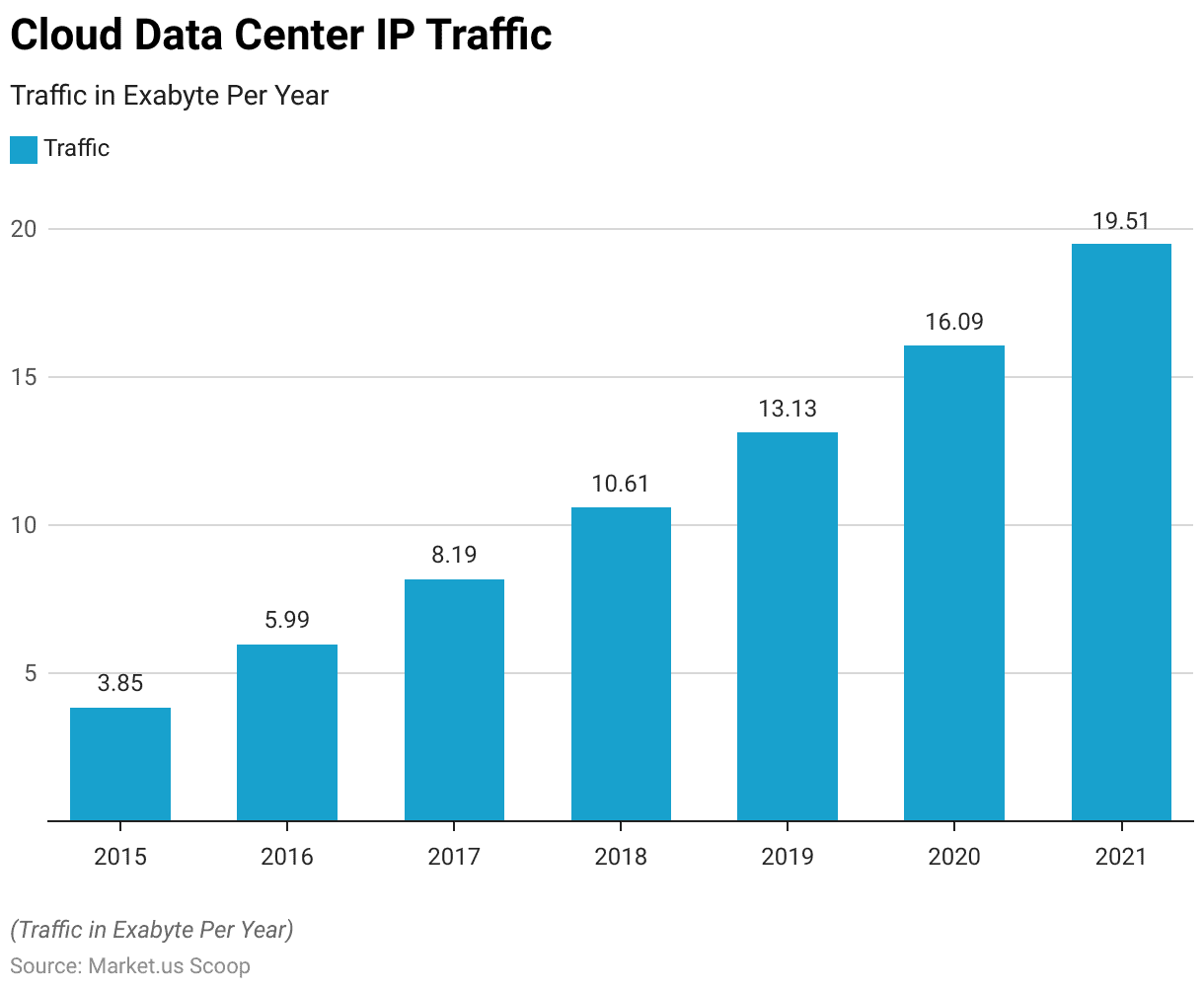
Global Cloud Data Center IP Traffic Growth
- The growth of cloud data center traffic has shown a significant upward trend from 2016 to 2021.
- In 2016, the traffic was recorded at 6.0 zettabytes per year, which increased to 8.2 zettabytes in 2017.
- This growth continued steadily, reaching 10.6 zettabytes in 2018 and 13.1 zettabytes in 2019.
- By 2020, the traffic had grown to 16.1 zettabytes, and in 2021, it reached 19.5 zettabytes per year.
- This consistent increase highlights the expanding demand for cloud services and the ongoing digital transformation across various sectors.
(Source: Cisco)
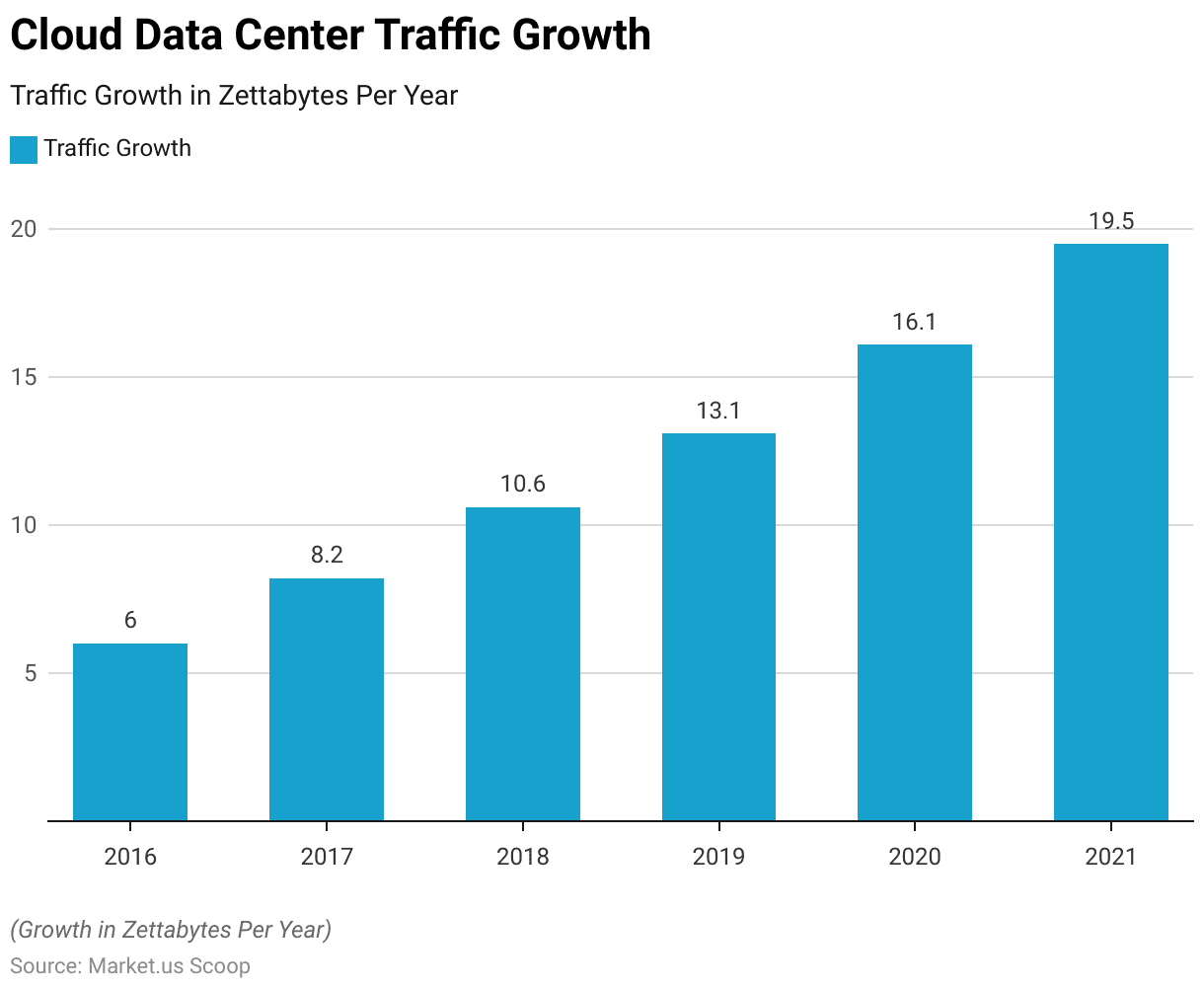
Components of Data Center Accelerator Statistics
- Datacenter accelerators comprise several key components, each designed to enhance performance and efficiency.
- Key components include Central Processing Units (CPUs), Graphics Processing Units (GPUs), Application-Specific Integrated Circuits (ASICs), and Field-Programmable Gate Arrays (FPGAs).
- For instance, the AMD Alveo U280 Data Center Accelerator Card features 8GB of HBM2 memory with up to 460GB/s bandwidth, designed for memory-bound, compute-intensive applications like database analytics and machine learning inference.
- Another example is the NVIDIA H100 Tensor Core GPU, which offers up to 256 GPUs interconnected with NVLink for exascale workloads, enhancing scalability and security.
- These components collectively drive the advancements in data center performance by providing high-speed processing capabilities and adaptability to various computational demands.
(Source: AMD)
Key Investments
- Between 2015 and 2022, data center investments worldwide saw significant fluctuations across single-asset, portfolio, and entity-level transactions.
- Single-asset investments began at $1.72 billion in 2015, peaked at $7.7 billion in 2021, and settled at $3.97 billion in 2022.
- Portfolio transactions experienced notable highs and lows, starting from $0.3 billion in 2015, spiking to $3.44 billion in 2017, and dropping to $0.2 billion in 2022.
- Entity-level investments demonstrated considerable variability, commencing at $2.03 billion in 2015, reaching a high of $6.97 billion in 2022 despite a low of $1.46 billion in 2020.
- These trends reflect evolving strategies and market dynamics within the data center investment landscape.
(Source: Statista)
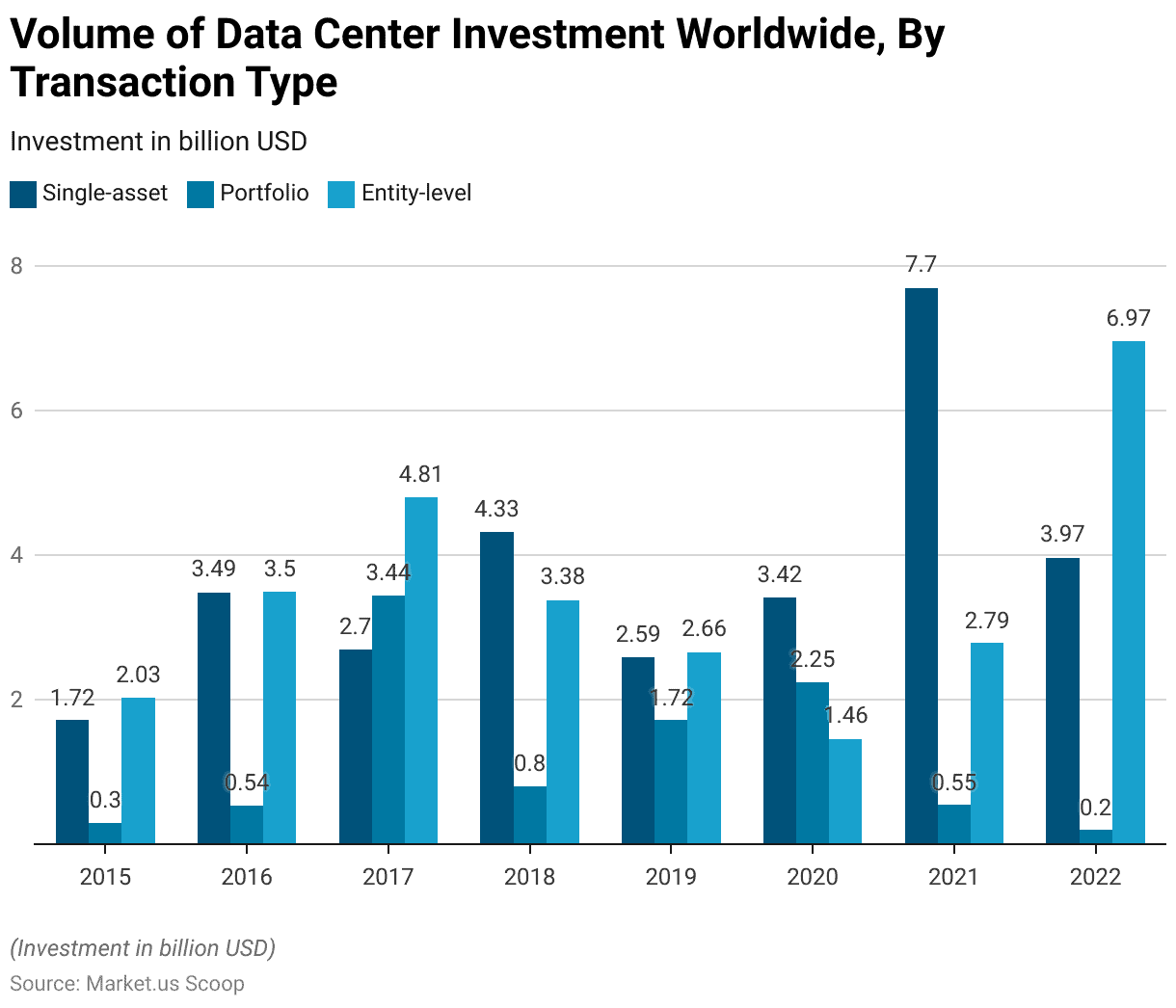
Regulations for Data Center Accelerator Statistics
- Regulations for Data Center Accelerators vary by country and are influenced by factors such as data privacy, energy efficiency, and environmental sustainability.
- In the United States, data center regulations are primarily governed by industry standards such as the Uptime Institute’s Tier Classification System and the Energy Star program.
- Additionally, regulatory bodies like the Environmental Protection Agency (EPA) and the Department of Energy (DOE) set guidelines for energy efficiency and environmental impact.
- In Europe, the General Data Protection Regulation (GDPR) mandates stringent data privacy measures for data center operations.
- Countries like Germany have specific regulations for data processing and storage, ensuring compliance with EU data protection laws.
- In the Asia-Pacific region, countries like Singapore promote green data center initiatives through regulations like the Green Data Centre Standard (GDCS), which focuses on energy efficiency and sustainability.
- These regulations aim to ensure the responsible and sustainable growth of data center accelerators while addressing concerns related to data security, energy consumption, and environmental impact.
(Source: KPMG)
Recent Developments
Acquisitions:
- AMD’s Acquisition of Pensando Systems: In May 2022, AMD completed the acquisition of Pensando Systems for approximately USD 1.9 billion. Pensando’s platform adds high-performance data processing units and software stack capabilities to AMD’s data center product range, enhancing their offerings for cloud and business clients like Goldman Sachs, IBM Cloud, Microsoft Azure, and Oracle Cloud.
New Product Launches:
- AMD Instinct MI300 Series: AMD launched the Instinct MI300X and MI300A data center AI accelerators in December 2023. These accelerators are designed for training and inference solutions in AI workloads. They feature the new ROCm 6 software stack, which supports large language models and provides significant performance optimizations.
- Intel Xeon Processors and Gaudi2 AI Accelerators: Intel introduced its next-generation Xeon processors and Gaudi2 AI hardware accelerators. These innovations are aimed at enhancing AI performance and efficiency in data centers. Intel’s Gaudi2 accelerator is positioned as a key component in AI supercomputers, such as those being developed with Stability AI.
Funding:
- Investment in AI and High-Performance Computing: The data center accelerator market continues to receive substantial investments aimed at integrating AI and machine learning capabilities into data center operations. Companies are focusing on expanding their high-performance computing (HPC) and AI training infrastructures to meet the growing demand for advanced computing solutions.
Market Growth:
- Significant Market Expansion: The growth is driven by the increasing adoption of AI and machine learning technologies in data centers.
- Regional Growth Trends: The Asia-Pacific region is expected to record the highest demand for data center accelerators during the forecast period. This is due to the rapid adoption of cloud services and AI technologies in the region.
Innovation and Trends:
- Integration of Advanced Technologies: Companies like AMD and Intel are integrating advanced technologies such as AI, machine learning, and high-performance computing into their data center accelerator products. These innovations aim to improve data processing speeds and efficiency, catering to the growing demands of modern data centers.
Conclusion
Data Center Accelerator Statistics – In conclusion, Data Center Accelerators, comprising GPUs, CPUs, FPGAs, and ASICs, significantly boost data center performance by expediting tasks like AI and ML computations.
This market is rapidly expanding due to increased demand for high-performance computing and big data analytics.
Despite challenges such as energy consumption and data security, ongoing innovation, and technological advancements are expected to drive continued growth and adoption, shaping the future of data center infrastructure and enabling advanced data-driven applications.
FAQs
A Data Center Accelerator is a hardware device or component designed to enhance the performance of data centers by offloading and accelerating specific tasks such as data processing, artificial intelligence (AI), and machine learning (ML) computations.
Data Center Accelerators work by employing specialized processors or co-processors optimized for specific tasks like parallel computing, deep learning, or cryptography. These accelerators offload intensive computational tasks from the central processing unit (CPU) to improve overall system performance and efficiency.
Common types of Data Center Accelerators include Graphics Processing Units (GPUs), Central Processing Units (CPUs), Field-Programmable Gate Arrays (FPGAs), and Application-Specific Integrated Circuits (ASICs). Each type offers unique capabilities and is suitable for different applications and workloads.
Using Data Center Accelerators can lead to significant performance improvements, increased processing speeds, reduced latency, and enhanced energy efficiency. These accelerators are especially beneficial for tasks requiring large-scale data processing, AI, and ML computations.
Data Center Accelerators are commonly used in various applications, including AI and ML training and inference, scientific simulations, big data analytics, image and video processing, and cryptographic operations. They play a crucial role in powering modern data-driven technologies and applications.
Discuss your needs with our analyst
Please share your requirements with more details so our analyst can check if they can solve your problem(s)



